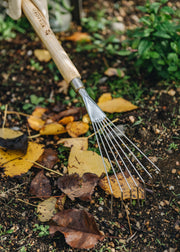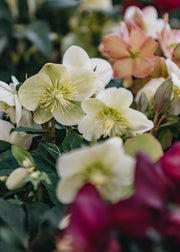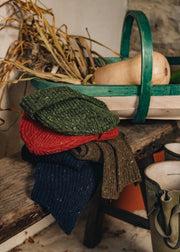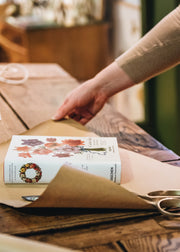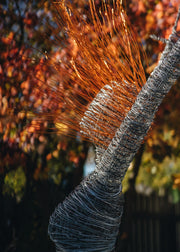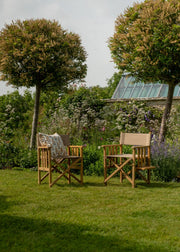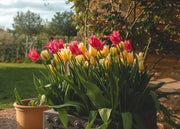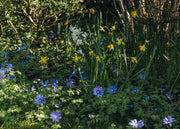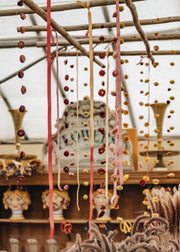Arthur Parkinson's Bulb Lasagne planting tips
The time has come to start planning and choosing spring flowering bulbs, ready for when nature reawakens in a burst of colour and fragrance next spring. We were thrilled to be joined by Arthur Parkinson at 'Bulb Mania', our festival to celebrate all things spring-flowering bulbs, so thought to share notes from his talk, ready for the planting season ahead.

All pots MUST have good drainage. Ensure that pot’s drainage holes aren’t clogged up with compost, by covering them over with crocks and gravel.
Use a good peat free multipurpose compost and grit, especially for lilies and alliums – both in pots, and if you are planting into the ground and your soil is heavy (clay). Lilies are especially perennial if planted into a gritty mix of ericaceous compost.
Blood fish and bone is a helpful fertiliser to add to pots when you are planting bulbs, but be aware that it can attract rats and squirrels due to its smell, so store it securely – in a metal tin!
Squirrels will ruin tulip displays in pots. The best solution is to cover pots over with dense sprigs of holly/rose prunings, but gardens plagued by squirrels may have to admit defeat and opt for narcissi instead, squirrels won’t eat these as they are poisonous. Black chicken wire and upturned hanging baskets that you can peg down with tent pegs around the inner rim of the pot will also give protection.
If the spring (late March and April) is dry then pots of tulip bulbs especially will need to be watered to reach their full potential and height. Remember that little terracotta pots, due to them being porous, are especially at risk of being thirsty.


Less is in fact more when it comes to tulips that are within layers of other bulbs because their foliage is quite big and they need air to be able to move through them to help combat fungal ailments. I now don’t plant more than 25 tulip bulbs in my combinations for pots that have a width that is on average 17 inches wide. I plant a large number of crocus, usually 40 for a pot this size, 20 muscari, 15 iris reticulata and 7 hyacinths. Less tulips if I am going to combine them with narcissi.
If you are going to place growing plants on top of a bulb lasagne such as geums, bronze fennel, a cardoon or winter/spring bedding, violas, forget-me-not, or wallflowers, then you’ll want half the number of bulbs stated above because too many will over crowd these as they grow and the display will fail due to a lack of air circulation between the plants.
For a three layered bulb lasagne, you want to give yourself a planting depth of 12-15 inches to allow for bulbs, then layers of compost. Tulips always go deepest.
Little early spring bulbs such as crocus and snowdrops and also hyacinths, species tulips, snakes head fritillary look especially effective planted into table top terracotta bowls and pots that can be top dressed with moss (raked up for free from the lawn). Grouped together, these give good impact and they can also be brought into the house as living flower arrangements provided they are kept well watered and the central heating isn’t on full blast. They last best in cool rooms or give them relief by putting them in the porch at night time.
Rather than planting one variety per pot, Lasagne Planting is the technique of layering bulbs for a near constant succession of flowers, a planting style that promises layers of blooms erupting in a harmonious and long-lasting display throughout the spring.
The tallest and latest flowering bulbs are positioned at the bottom of the pot, working up to the shorter and earlier flowering bulbs on top. Two layers of bulbs in a pot works well, but you can plant up to three layers for a real show stopper of a display. You can also plant ‘pot toppers’ like violas, pansies, cyclamen and heather for colour through the winter.

Lasagne planting cross section
Begin by picking spring flowering bulbs and plants that boast varying heights and bloom times. With a good spread of blooming times, you are then sure to have a long lasting display, as earlier varieties eventually overlap and fade to make way for later bloomers. A well chosen gradual crescendo of violas, crocuses, daffodils, and tulips – will bring pure joy and cheer in those future darker months.
Choose a generously sized container, ensuring there are holes at the bottom for drainage. Begin by placing a layer of peat-free compost, mixed with grit or sand to enhance drainage. You can also add bulb starter, to ensure an ongoing healthy display throughout the season.
Plant your tallest and latest blooms at the bottom of your container, up to eleven inches deep. Gently nestle them into the soil, packing in many for a full and generous display, ensuring your spacing is around one and a half inches. Bulbs can be planted closer together than you would typically in the border, but ensure they do not touch, to prevent rotting. Cover with a layer of compost, around two inches worth, and your bulb starter if using, and prepare to plant your next layer.
Tall later bloomers - perfect for your bottom layer
Planting deeper means there is further for the keen green shoots to travel before they reach the spring sunshine. So, once your first layer has gone over, the middle layer will take centre stage to continue to symphony. Plant your bulbs as before, in a peat-free compost and grit mix. Don’t worry about your layer below, as the bulbs will grow around the layer above them, finding a gap where they can. Add another layer of compost and bulb starter and prepare for your final layer.
Midseason bloomers - perfect for your middle layer
Finally, add your smallest bulbs, ready to flower first. Plant them closest to the surface, and top off with a final layer of compost. You can also top with a layer of grit to help protect them, and to prevent surface run off when watering, or too much evaporation.
Small and first to flower - perfect for your top layer
Water your layered creation gently to settle the soil and activate growth. Depending on your garden visitors, protection from hungry squirrels and mischievous mice may be advisable. For a natural barrier, cut stems of spikey Holly and form a criss-cross pattern to make a prickly barrier.
As the first notes of spring warmth arrive, each layer will awaken in its own time, unveiling your harmonious blend of colours and fragrance.


